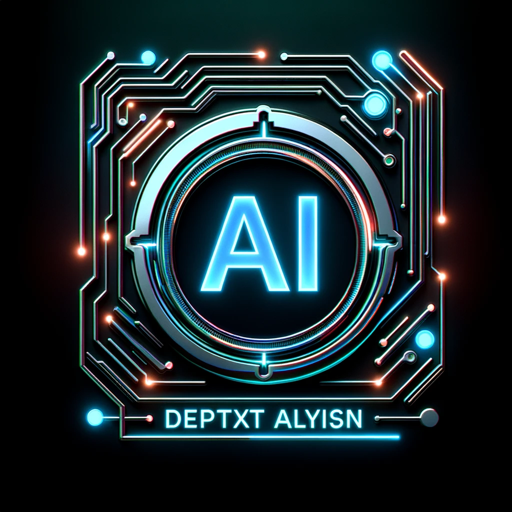Written by AI Spot Check-AI text authenticity verification
AI-powered text verification tool
I'm going to give you a text blub that i want you to analyze if it was written by AI.
Analyze the document I've attached and tell me what % chance it was written by AI
Was this this article on this URL written by AI?
Related Tools
Load More
GPT Detector | Ai Detector | Ai Checker
Convert text to human, humanize my article, enhance blog content, score my blog's AI

AI Screenplay Critic
Provides feedback on screenplays, analyzing structure, character development, and dialogue with suggestions for improvement.

Essay Checker
AI essay checker & revision tool helps you refine essays, master grammar, & build strong writing skills.

去ai写作痕迹专家
模拟人类语言和思想的论文写作助手

Copy Editor Bot - CE 101
Paste in your content and I'll suggest copy edits to improve it. ➡️ Learn more at contentediting101.com

Copy Editing GPT
Copy Editing GPT: Providing Answers with Improved Grammar and Enhanced Sentences Only
20.0 / 5 (200 votes)
Introduction to Written by AI Spot Check
Written by AI Spot Check is a specialized AI text classifier designed to distinguish between AI-generated and human-authored texts. It leverages advanced natural language processing (NLP) techniques, deep learning models, and pattern recognition to analyze and assess the probability of a text being AI-generated. This tool is particularly useful in scenarios where the authenticity of content is critical, such as in academic publishing, digital media, and legal documentation. For example, in an academic setting, Written by AI Spot Check could be used to verify whether a student's essay is original or generated by AI, ensuring academic integrity.

Core Functions of Written by AI Spot Check
Text Classification
Example
Determining whether a news article was written by an AI model or a human journalist.
Scenario
A media company could use this function to validate the authenticity of articles before publication to avoid misinformation.
Probability Calculation
Example
Calculating the likelihood that a piece of content, such as a social media post, was generated by AI.
Scenario
Social media platforms can employ this feature to flag suspicious posts that might be generated by bots, enhancing content moderation.
Detailed Analysis
Example
Providing a detailed breakdown of text features that indicate AI authorship, such as inconsistencies in style or unnatural phrasing.
Scenario
Legal professionals might use this to analyze contracts or legal documents for signs of AI-generated content, ensuring authenticity and reducing the risk of fraud.
Target Users of Written by AI Spot Check
Academic Institutions
Universities and schools that need to ensure the originality of student submissions. They benefit from the tool's ability to detect AI-generated content in essays and research papers, thereby upholding academic standards.
Media and Publishing Companies
These organizations require verification of the authenticity of content before publication. Written by AI Spot Check helps them prevent the spread of misinformation and maintain the credibility of their published work.

Guidelines for Using Written by AI Spot Check
Visit aichatonline.org for a free trial without login, also no need for ChatGPT Plus.
Begin by navigating to the website where you can access the tool immediately without the need for a login or a premium subscription. This makes it accessible and easy to try.
Upload or paste the text you want to analyze.
You can either upload a document or directly paste the text you wish to check. The tool will then start processing the content.
Review the probability score provided by the tool.
The tool will generate a probability score indicating the likelihood that the text was generated by AI. This score is based on advanced analysis of linguistic patterns and structures.
Request a detailed breakdown (optional).
If you want to understand why a particular probability was given, you can request a breakdown of the analysis. The tool will provide a concise explanation of the key indicators that influenced the result.
Use the insights for your specific needs.
Apply the findings from the analysis in various contexts such as academic research, content creation, or verifying the authenticity of written material.
Try other advanced and practical GPTs
Story AUTHORity Creator
Transform your story into success.

Service Page Topical Authority SEO Generator
AI-powered tool for building SEO authority.

CineFlow Script Coverage
AI-powered insights for screenplays.

Screenplay Coverage
AI-powered Screenplay Analysis

Effective, Gentle, and Optimization-Focused
AI-Powered Solutions for Complex Queries

Ordinary Differential Equations II Tutor
AI-powered insights for mastering complex ODEs.

Chinese Academic Research Assistant
AI-powered assistant for academic excellence.

Academic Research Notes in APA 7 from PDFs - v2.0
AI-powered annotated bibliographies made easy

Economics + Math 📊
AI-powered insights for economics and math

Math Mentor
AI-powered Math Learning Companion

Code
AI-driven insights for firmware excellence.

Specific Writing Helper - CE 101
Enhance writing precision with AI assistance.

- Academic Writing
- Content Verification
- Misinformation Detection
- Plagiarism Prevention
- Authenticity Check
Common Questions About Written by AI Spot Check
What does the probability score represent?
The probability score indicates the likelihood that the text was generated by an AI system. A higher score suggests a greater chance of AI authorship.
Can the tool analyze texts in different languages?
Yes, Written by AI Spot Check can analyze texts in multiple languages, making it versatile for international users.
How accurate is Written by AI Spot Check?
The tool leverages advanced models and extensive datasets to provide highly accurate assessments, though no system can guarantee 100% accuracy.
What are the common use cases for this tool?
Common use cases include academic integrity checks, content verification, and ensuring the authenticity of online reviews or articles.
Is there a limit to the text length that can be analyzed?
There may be practical limits based on the system's processing capacity, but most standard documents can be analyzed without issues.